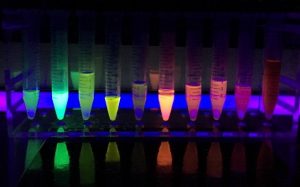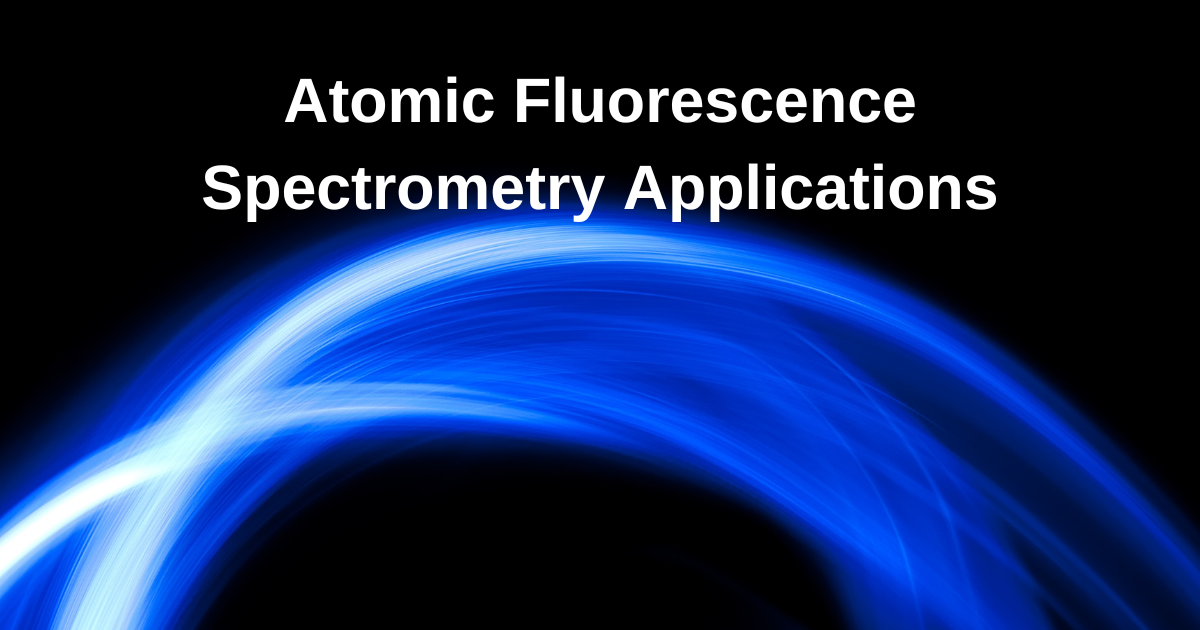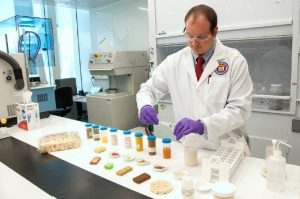Atomic Fluorescence Spectrometry (AFS) is an analytical technique that is  primarily used to detect and quantify metals. It is an exceptionally sensitive technique that relies on exploiting the distinctive fluorescent spectra of each specific metal. Using AFS, the detection of antimony, arsenic, bismuth, cadmium, germanium, lead, selenium, tellurium, tin, and zinc can be done at very low concentrations; some of these metals can be detected in the single-digit parts-per-billion (ppb) range. The following article acts as a general overview of AFS instrumentation, in both the steps required for analysis and some areas of applications.
primarily used to detect and quantify metals. It is an exceptionally sensitive technique that relies on exploiting the distinctive fluorescent spectra of each specific metal. Using AFS, the detection of antimony, arsenic, bismuth, cadmium, germanium, lead, selenium, tellurium, tin, and zinc can be done at very low concentrations; some of these metals can be detected in the single-digit parts-per-billion (ppb) range. The following article acts as a general overview of AFS instrumentation, in both the steps required for analysis and some areas of applications.
AFS Procedural Overview
Before injection into the instrument, samples are usually pre-treated to remove extraneous contaminants or to clean up sample consistency. The extent of these pre-treatments depends on the sample composition itself, as well as the atomizing method. For example, diluting the sample is usually enough when the sample is a homogenous, non-viscous liquid, and a graphite furnace is utilized as the ionization method. However, a more extensive preparation involving microwave-assisted digestion of the sample with excess acid and/or peroxide may be required for vapour-hydride generation as the atomization method.
The first component of an AFS instrument is how the element is atomized and introduced into the analysis chamber. Three commonly employed methods for atomization are flame, graphite furnace, and vapor-hydride generator.
AFS – Ionization
Flame ionization is one of the oldest and most affordable methods for sample ionization. The sample (in solution) is directly injected into the flame, decomposing all organics and atomizing the remaining metallic components. Depending on the necessary temperature, a mixture of air and acetylene gas (2300oC) or nitrous oxide and acetylene gas (2700oC) may be used. The primary disadvantage of flame ionization is the safety hazard of an open flame, in addition to the presence of a pressured acetylene canister. Additionally, sample addition is typically a continuous process through a tube that adds sample into the flame, limiting the capability of this method when sample volume is restricted.
In graphite furnace ionization, the sample is directly deposited onto a tube of graphite. A current is passed through the graphite, causing it to heat up via ohmic resistance. This heating occurs in three stages, each with a different purpose. The first step involves drying the sample, and this occurs between 60-100oC. In the second step, the temperature is increased further to pyrolyze (decompose) any organic material within the sample; this step can be from 250-900oC. The final step is sample atomization, and this usually occurs over 2000oC. At these high temperatures, the potential for sample reactivity with nitrogen gas makes this an unsuitable carrier gas; instead, argon is typically utilized. The entire ramping process, including holdings, usually occurs across 1-2 minutes, which is a longer time frame than flame ionization. However, this method allows for enhanced sensitivity, and analysis can be done on minute quantities of sample.
The final and most modern method is vapor-hydride generation. In this set-up, a pre-treated, acid-digested sample is first reduced by a hydride-source. The volatility of the newly generated metal-hydride is exploited by a vapor-liquid separator, which funnels the gaseous-metal-hydride into a heated detection cell. The heat causes the decomposition of the metal-hydride into H2 gas and the desired atomized metal. Though more complicated and costlier than either the flame or the graphite furnace ionization methods, the generated metal-hydride is exceptionally pure, leading to reduced interference and up to a 3000 times increase in sensitivity. This makes this method one of the most sensitive atomization methods available not only for AFS, but also other trace-metal focused elemental analysis procedures, such as Atomic Absorbance Spectrometry (AAS).
AFS – Detection
AFS detection starts with an element-specific, monochromatic lamp. This lamp is pointed directly at the ionized atoms, causing excitation of the electrons within fluorescence signals being emitted in all directions. The detector, a photomultiplier tube, is placed 90o to the lamp; this is done so that stray light from the source lamp does not hit the photomultiplier tube. Typically, the detector will be solar-blind, meaning that ambient light (from sources such as sunlight or other illuminating sources) will not generate a signal. By using an element-specific lamp, and combining that with various background correction technologies, exceptional sensitivity can be achieved for the detection of metals in a variety of samples.
AFS Application Areas

As AFS offers exceptional sensitivity for elements of interest to human health, including lead and mercury, several application areas have been developed for AFS. Of note, mercury detection can be conducted down to the ppt (parts-per-trillion) range. AFS has been used to test for mercury in environmental samples such as water. More novel applications have also been developed; for example, cadmium sulfide quantum dots coupled with AFS can be used to quantify target DNA in a sample, which may have future uses in early cancer detection and tumor biomarker identification. Due to the high sensitivity of AFS, it has also been used to detect cadmium and lead in human hair samples, with detections limits as low as 0.05 and 3 ppm respectively. These findings could have future applications in forensic sciences and toxicology.
Another important application of AFS is in studying the speciation of metals within samples. For certain metals, including mercury and arsenic, the compound that the metal is in determines whether it is toxic or (relatively) benign. For example, inorganic arsenic is a poison and can have detrimental effects on human, animal, and environmental health. On the other hand, organic arsenic complexes are relatively harmless and are found in many environmental samples and the foods we eat. As such, understanding the distribution of these element-containing species within a sample is critical to a safety assessment. Many techniques to separate these compounds prior to AFS analysis have been devised. One such technique is the use of HPLC prior to AFS analysis. Coupling sample work-up to HPLC and AFS allows the user to gain a more complete picture of the nature of the elements of interest within the bulk sample.
The Aurora Advantage
One of the great benefits of the Aurora’s LUMINA Atomic Fluorescence Spectroscopy instrumentation is the incorporation of a state-of-the-art XYZ autosampler, allowing direction injection of multiple samples from virtually any size and type of vial or sample container. Coupling this with our advanced vapor-hydride generation, the LUMINA AFS provides exceptional sensitivity with industry-leading automation to substantially increase your workflow and increase your laboratory efficiency.




